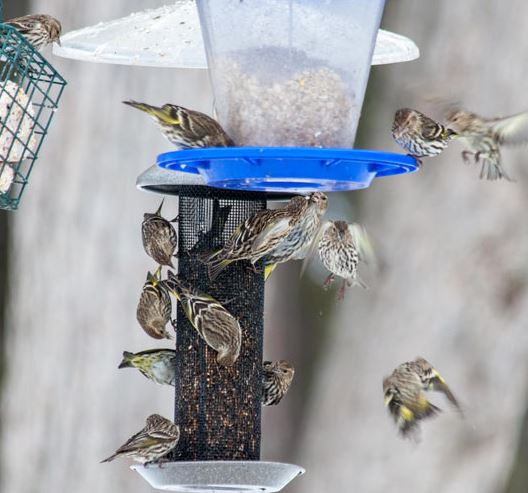
Local expert talks Winter Irruption
Watching beautiful, peaceful birds, what better way is there to relax and unwind? Let’s not forget the squirrels and other wildlife that may frequent your lawn in the wintertime. Until I had the time to pay attention to seasonal changes and the movements of birds, I had never heard the word “irruption”. We all know the word “eruption” – think lava bursting out of a volcano. Irruption is a word used by ecologists to describe a sudden, rapid, and irregular increase in an animal population. It typically involves some kind of change in the natural ecological checks and balances.
For birders, an irruption is a sudden, dramatic increase in a bird population, often outside the expected range for the species.
Irruptions are not like migrations. Many bird species migrate regularly, moving from one habitat to another in the spring and fall to nesting grounds to raise their young. But irruptions are irregular. They occur during the winter, but not every year. Indeed, many species that irrupt do not migrate with the seasons at all. Instead, every few years a group of birds — sometimes many species together — end up far south of their normal wintering grounds.
Winter irruptions are driven by conditions in the northern forests.
The prevailing wisdom has it that the irregular winter irruptions into southern Canada and the lower 48 states are triggered by food shortages caused by the large-scale collapse of seed and catkin production in northern Canada’s birch, maple, pine, spruce, hemlock and fir forests that serve as the birds’ normal wintering grounds.
From a seed’s point of view, seed-eating birds are deadly. So the trees fight back by controlling the food supply. They save up to produce massive amounts of seeds in one year and very few the next. In years with lots of seeds, birds may have more than they can eat, so some survive to germinate; in years without seeds, birds must take to the skies to find better pickings.
Famine can force large numbers of birds to seek more plentiful habitats until seeds, flowers and insects return in the spring. Many seed-eating boreal species are subject to irruptions, including Bohemian and Cedar Waxwings, boreal chickadees, purple finches, pine and evening grosbeaks, red-breasted nuthatches, redpolls and pine siskins.
Irruptions also may occur when a bird population has exploded in number (overbreeding). Snowy owls are a prime example. Within the last few years, snowy owls have been seen on Long Island, the shores of Maryland and as far south as Florida. High populations of lemmings, voles, ptarmigan and other prey lead to large clutches of owl eggs. With many more mouths to feed, these birds now may need to fly elsewhere for food.
Different birds of prey may also irrupt when the seed crops are poor and cannot support the necessary rodent populations for raptor food sources.
Other causes for bird irruptions include unduly harsh cold or severe weather that may force birds to find more temperate wintering grounds.
The exact circumstances that can prompt an irruption for any of these species will vary, as will the scope of the population shift and where the irrupting birds appear south of their normal ranges.
What is clear is that persistent shifts in rainfall and temperature drive seed production, which in turn drives the irruptions. “It’s a chain reaction from climate to seeds to birds,” says atmospheric scientist Court Strong, an assistant professor at the University of Utah.
Bird irruptions can add excitement to winter birding. While birders should never count on an irruption, it can be a pleasant surprise when northern birds appear at our southern feeders. Keep on the lookout! Better yet, visit our Wolfpit Preserve in Bethel.